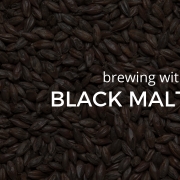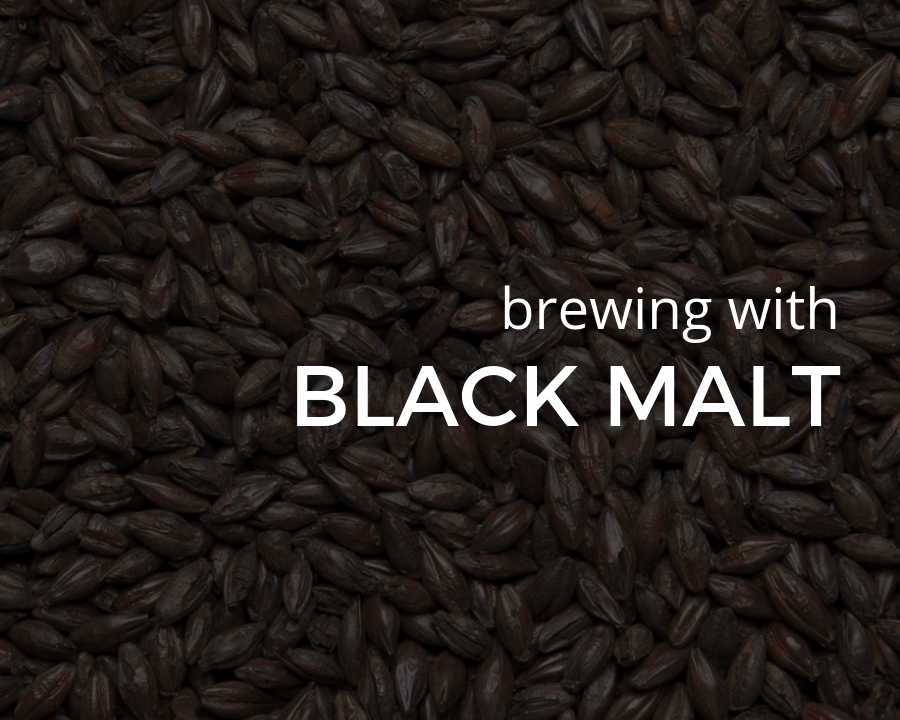Brewing With Black Malt
Black malt or black patent malt is one of the three main dark grains that are synonymous with brewing dark beers. Although it has not quite got the allure of chocolate malt or roasted barley, partly due to the name, it is still essential to brewing not only dark beers but adding colour and complexity to other beers. In this article, we will take a look at how black malt is made and how to use it in your beers.
Table of Contents
Black Malt: An Obvious Name
Black malt has an unfortunate name and not a stellar reputation in most brewing literature. Unlike chocolate malt or roasted barley whose names evoke something a little more appealing than black malt, it is, however, easy to see why it is called black malt.
Just take a look at black malt and you can see it is completely black and generally when you perceive something black it doesn’t necessarily look appetising. It has led black malt to have a reputation of tasting acrid and burnt in some cases. Is this really the case?
What Does Black Malt Add To A Beer?
First and foremost black malt adds colour to a beer and is primarily used in dark beers on its own or alongside other dark grains. It’s one of the darkest grains available to brewers and used in any large amount will produce dark-brown to black beers. Used in smaller amounts, however, it is a useful malt to adjust the colour of beers.
Whilst black malt provides a lot of colour to a beer it is useful to note that it does not colour the beer foam. This can result in fluffy white heads on the finished brew whereas other dark grains can turn the beer foam a cream, tan or brown colour.
Black Malt For Colour Adjustments
Black malt often finds itself in recipes as a means of making it slightly darker. Used in small amounts you can achieve a shade darker tan or even a reddish hue to a beer.
The usefulness of black malt used in small amounts like this is the flavour imparted is minimal. Most people expect even a small amount of black malt to add burnt, roasted flavour to the beer but this is not true. Used in small amounts black malt can be really subtle. It is not until you start increasing the proportion of black malt that the flavour really starts punching.
Black Malt Flavour
The flavour of black malt is of moderate roastiness and a combination of coffee, bitter chocolate and an acidity. The more you use the more it can, of course, overpower a beer but used alongside other malts it can be very characterful.
How Black Malt Is Made
Black malt starts life as pale malt like most other malted grains. Unlike a grain like roasted barley that is unmalted.
The pale malt is loaded into a roasting drum and heated to 220 – 230°C (428 – 446°F). The malt is then kilned for a period of up to 4 hours. The black malt has to be carefully watched as if the roasting goes on for too long the malt will literally turn to charcoal and burn.
Debittered Black Malt
Many maltsters offer a debittered black malt to produce beers with lots of colour without flavour associated with dark grains. The process of producing debittered black malt involves removing the husk of the grain. The husk on the grain when roasted produces bitter flavours so by removing the husk you have a grain that has a smoother less astringent character in the finished beer.
Amount Of Black Malt To Use
- Typically up to 10% in Porters. Stouts and other dark beer.
- 1 – 3% to add colour to lighter beers.
Used on its own or with other dark and roasted grains black malt is used as up to 10% of the malt bill in stouts and porters. Black malt adds colour without so much of the flavour as roasted barley so it is good to boost colour without overpoweringly roasty notes.
In lighter beers, it adds colour without flavour which is particularly useful in schwarzbiers, dark lagers and dark beers where you do not want so much of the roasted flavour.





Can priming sugar be used with black malts?
I am not sure I understand the question. If you make a beer using roasted malts it won’t effect the use of priming sugar. Use priming sugar like you would with any other beer.